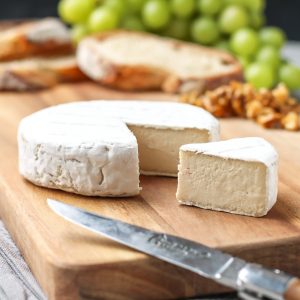Vegan Aged Camembert Cheese
4.9
(233)
Your folders
Your folders
Prep Time: 50 minutes
Servings: 3
Author : Full of Plants

Ingredients
Export 3 ingredients for grocery delivery
Instructions
Step 1
Soak the cashews in filtered water for at least 5 hours or overnight.
Step 2
Drain the cashews and place them in a large glass bowl. Bring a large pot of water to a boil. Once boiling, pour the water directly onto the cashews. Let sit 1-2 minutes and drain the cashews again. This step will help kill possible bacterias.
Step 3
Place the cashews in the bowl of a blender or food processor. Add 8 tablespoons of filtered water. Blend on high speed, scraping down the sides from time to time, until you get a very smooth and thick mixture. This step might take about 10 minutes depending on your blender.
Step 4
Open the probiotic capsules and add the powder to the bowl.
Step 5
Add the penicillium candidum, just 4 drops is enough (about 1/8 tsp). If your penicillium candidum is in powdered form, please check the notes.
Step 6
Blend on high speed for another 10-15 seconds.
Step 7
The cashew cream should be smooth but quite thick. If needed, add 1 tablespoon of water at a time until smooth. Do not add too much water, or your mixture will be too liquid.
Step 8
Transfer the cashew cream to a clean glass bowl, cover with plastic film to touch, and let sit at room temperature for one day in a dark place, this step is important to let the cheese ferment.
Step 9
The following day, place the bowl in the refrigerator for about 4 hours. The cashew cream will firm up a bit and become easier to work with.
Step 10
After that, line a clean baking sheet or flat plate with parchment paper. Place 3 small springform pans (I used 4-inches pans without the bottom) on the baking sheet.
Step 11
Cut strips of parchment paper and lay them in the springform pans. You want to cover the sides of the springform pans, you can also use plastic film if you prefer. The goal is to prevent the cheese to touch the metal. Fill each pan with the mixture and press it down using plastic film so it doesn't stick to your hands.
Step 12
Cover each cheese with a bowl or plastic box. This is essential to prevent the cheeses from drying. Let sit in a room at a temperature of about 52-56 degrees Fahrenheit (11-13°C). You can also age them in a refrigerator, it might just take a little longer for the mold to grow. Note: You will age the cheeses, covered, at this temperature for the next two weeks. Do not store them at a temperature higher than 56°F (13°C).
Step 13
The next day, carefully remove the cheeses from the springform pans. Sprinkle the salt over the top of the cheeses. Next, using another plate lined with parchment paper, very carefully flip them. Sprinkle the tops and sides with more salt. The cheeses will still be very soft, like cream cheese. Don't worry they will be easier to work with after 3-4 days as salt will remove some moisture.
Step 14
Continue to flip the cheeses everyday (do not resalt). Always use clean hands or work with gloves (or plastic film) to make sure you are not touching the cheese.
Step 15
After 7 days, they should be a little bit harder and you should be able to place them on a bamboo mat or plastic grid.
Step 16
Flip them everyday for the next week. The mold will appear after 5-7 days and continue to grow until they are fully covered with a white rind.
Step 17
After 2 weeks, wrap the cheeses in parchment paper or cheese paper and place them in the refrigerator for at least 2 days. The longer you let them age in the refrigerator, the stronger the taste.
Step 18
Enjoy with french bread, fresh figs or walnuts!
Step 19
The cheese will keep for at least 1 month in the refrigerator.